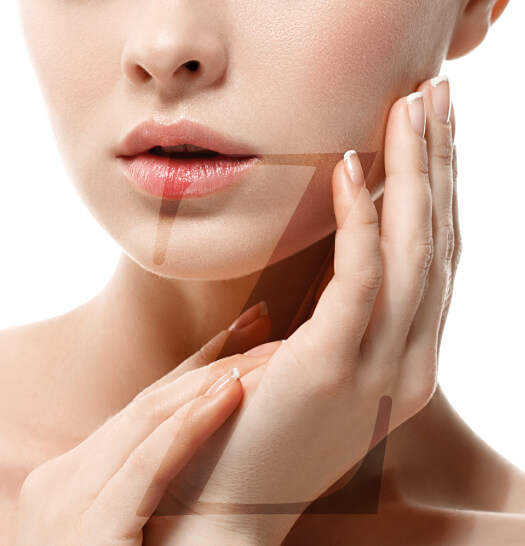Facial Fat Transfer
Conveniently located to serve the areas of Santa Monica, Beverly Hills and Greater Los Angeles
Fat transfer for the face, also known as fat grafting or micro-fat injection, is a cosmetic procedure that involves removing fat from one area of the body and transplanting it to another area to add volume and improve the appearance of wrinkles, lines, and hollow areas. The procedure is often performed on the face to enhance facial features, such as the cheeks, lips, and under the eyes. Fat transfer provides a natural and long-lasting solution for facial rejuvenation and can also be used in combination with other cosmetic treatments for optimal results. The procedure is minimally invasive and typically performed using local anesthesia, making it a safe and effective alternative to synthetic fillers.

Dr. Michael Zarrabi is a board-certified plastic surgeon that offers a wide range of treatments to enhance your appearance. His expertise allows him to recommend procedures that deliver the desired results, whether surgical procedures like facelifts or minimally invasive solutions like fat grafting. Get started and schedule a personal consultation by calling (310) 584-9990. His offices are located in Santa Monica and Beverly Hills to serve patients in Los Angeles and beyond. Call or fill out our inquiry form today!
Contents
About Fat Transfer for the Face
Facial fat transfer can transform an aging face by restoring a healthy, rested-looking appearance and revitalizing facial contours. The procedure involves removing excess fat from the patient’s own body, typically from the abdomen or thighs, purifying it, and then carefully injecting it into the desired areas of the face. Since the fat used is the patient’s own tissue, there is minimal risk of rejection or allergic reactions. Additionally, the results of a facial fat transfer are typically long-lasting, as the transplanted fat cells can survive and integrate into the surrounding tissue, providing a natural-looking and long-lasting result.
As we age, our skin loses elasticity, and fat deposits shrink, leading to a loss of volume in the face. This volume loss can cause the skin to sag and wrinkles and lines to become more pronounced. Fat loss in certain areas of the face can also create hollows and sunken cheeks, further contributing to an aged appearance.
Full, rounded cheeks, a smooth and wrinkle-free complexion, and well-defined facial contours typically characterize a youthful face. The skin is plump, hydrated, and radiant, and there are no deep lines or creases around the mouth, eyes, or forehead. The eyes are bright, with minimal puffiness or dark circles, and the lips are full and well-defined. Overall, a youthful face has a healthy, vibrant appearance with a balanced and symmetrical volume distribution.
How Does the Fat Survive Transfer?
The transplanted fat cells must survive and integrate into the surrounding tissue for a successful fat transfer. Fat cells survive by forming new blood vessels, which supply them with oxygen and nutrients necessary for growth and survival. This process is known as revascularization and is critical for the long-term survival of the transplanted fat. [1]
The survival of transplanted fat cells can be influenced by several factors, including:
- The technique used for fat harvest
- Preparation
- Injection
- Recipient site
- Individual anatomy and health
To increase the survival rate of transplanted fat cells, the procedure should be performed by an experienced practitioner using gentle and precise techniques. Additionally, a healthy lifestyle, including a balanced diet and regular exercise, can help to promote the survival of transplanted fat cells and ensure long-lasting results.
The Benefits of Facial Fat Transfer
Reversing the loss of volume in the face can help to restore a youthful, rejuvenated appearance and improve self-confidence. Fat transfer can help to:
- Plump depleted areas of the face
- Smooth out wrinkles and lines
- Restore the contours and definition of a youthful face
- Make you look years younger
- Slim down and contour the donor area
Though some of the transferred fat cells will not survive transfer, most will integrate and provide natural and long-lasting results. A loss of up to 45% of the original volume was observed in free-fat grafts after one year. This decline may be due to trauma during the grafting process or the fat cells’ inability to adapt to the new environment, resulting from insufficient blood supply. [2] Dr. Zarrabi takes great care and pride in providing excellent fat retention levels.
Fat transfer is a versatile and customizable treatment that can be tailored to the individual needs and goals of the patient, making it an attractive option for those seeking a more youthful and rejuvenated appearance.
Who is a Good Candidate for Fat Transfer?
Because fat transfer and injections use your tissues to produce volume in the treatment area, it is considered safe for most patients. Considerations for the procedure are the availability of fat from a harvest site on your body, such as the
- Abdomen
- Thighs
- Love Handles
Patients must have a deficit of volume in the treatment area to be considered a good candidate for facial fat transfer. Both men and women can benefit from this groundbreaking procedure.
However, like any cosmetic procedure, fat transfer has limitations and does not guarantee perfect results. Having realistic expectations and thoroughly discussing the procedure with Dr. Zarrabi is important to determine if it is the right choice for you. With proper care and maintenance, a fat transfer can help to restore a youthful and revitalized appearance, boost self-confidence, and enhance overall well-being.
Book a consultation with Dr. Zarrabi to determine if you are an ideal patient for this procedure.
Personal Consultation
A fat transfer consultation allows you to meet with Dr. Zarrabi’s team and learn more about facial fat transfer or any other procedure you are interested in. During the consultation, you can expect us to:
- Ask about any medical conditions or treatments you have had and any medications or supplements you are taking. This information is important for determining if you are a good candidate for the procedure.
- Examine your face, taking note of areas of volume loss and wrinkles, and discuss your goals and concerns.
- Explain the fat transfer procedure, its benefits and limitations, and any alternative treatments that may be available.
- Provide you with an estimate of the expected outcome, including the amount of volume that can be added, the length of the recovery period, and the longevity of the results.
- Answer any questions; this is your opportunity to ask questions or express concerns about the procedure.
The consultation is an essential part of the process and will help you to make an informed decision about whether a facial fat transfer is right for you. It is important to choose a practitioner who is experienced, knowledgeable, and has a good track record of performing fat transfer procedures to ensure the best possible outcome.
Preparing For Your Procedure
After the fat transfer consultation, there are several steps you can take to prepare for the procedure:
- If you smoke, it is important to quit several weeks before the procedure, as smoking can impede healing and increase the risk of complications.
- Avoid alcohol and any medications that cause bleeding, such as aspirin and non-steroidal anti-inflammatory drugs (NSAIDs), for several days before the procedure.
- Since the procedure may be performed under local or general anesthesia, you will need to arrange for a friend or family member to drive you home after the procedure.
- You should arrange for time off work and arrange for help with household and personal tasks during the recovery period.
- Confirm the date, time, and location of the procedure, as well as any pre-operative instructions provided.
It is important to have realistic expectations and to understand that while fat transfer can provide a rejuvenated and youthful appearance, it will not make you look like a different person. You will still be you, only younger-looking!
Dr. Zarrabi and his team will provide you with specific pre-operative instructions, including any dietary restrictions, to ensure optimal results and minimize the risk of complications. By following these steps and discussing any questions or concerns with Dr. Zarrabi or his dedicated staff, you can prepare for your fat transfer procedure and ensure the best possible outcome.
The Procedure
A clinical study showed how important the size of fat particles is to fat survival during a fat transfer procedure. Usually, fat doesn’t come in small particles, but it becomes that way when it’s taken out of the donor area. The study found that the fat cells closer to the skin’s surface have a better chance of living after the transfer. [3] Dr. Zarrabi uses this knowledge to inform where to remove donor fat for his patients to optimize transferred fat survival.
Once the patient has received anesthesia, Dr. Zarrabi will remove fat from a donor area, typically the abdomen, hips, or thighs, using liposuction. The fat is then processed and purified to prepare it for transfer.
The processed fat is then injected into the desired areas of the face using a small needle or cannula. Dr. Zarrabi will carefully place the fat in multiple layers, creating a natural and even appearance.
The total time required for the procedure depends on the extent of the transfer and the number of areas being treated. The procedure can be performed with other cosmetic procedures, such as a facelift, for enhanced results.
The Recovery
After the procedure, you may experience some swelling, bruising, and discomfort, which can usually be managed with over-the-counter pain medication. You will need to attend follow-up appointments with Dr. Zarrabi to monitor the healing process and ensure that the results are as desired.
The Results
The results of a facial fat transfer are typically long-lasting and can provide a natural and rejuvenated appearance. Most transplanted fat will survive, with touch-up treatments sometimes necessary to maintain the desired result.
Dr. Zarrabi is at the top of his class, performing procedures that can improve a patient’s life. With materials derived from the patient’s body, the results are naturally contoured facial features without the hard look of some fillers. Your face will move, and the transferred fat will move with it seamlessly.
What is the Cost of Facial Fat Transfer in Beverly Hills?
During your consultation, you’ll find out if fat transfer and injections are your best option, as well as other details, such as the cost of treatment.
The starting cost of our fat transfer and injections varies by patient and is based upon a treatment plan you developed during the consultation. The cost is based upon the volume of fat that is needed, as well as other factors. We will explain our financing options through CareCredit®.
Get started today; call (310) 584-9990 or fill out an inquiry form to get started.
References
- Shiffman MA, Mirrafati S. Fat Transfer Techniques: The Effect of Harvest and Transfer Methods on Adipocyte Viability and Review of the Literature. Dermatologic Surgery. 2001;27(9):819-826. doi:10.1046/j.1524-4725.2001.01062.x
- Gause TM, Kling RE, Sivak WN, Marra KG, Rubin JP, Kokai LE. Particle size in fat graft retention: A review on the impact of harvesting technique in lipofilling surgical outcomes. Adipocyte. 2014;3(4):273-279. doi:10.4161/21623945.2014.957987
- Kato H, Mineda K, Eto H, et al. Degeneration, regeneration, and cicatrization after fat grafting: dynamic total tissue remodeling during the first 3 months. Plastic and Reconstructive Surgery. 2014;133(3):303e313e. doi:10.1097/PRS.0000000000000066













